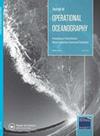A new 30 meter resolution global shoreline vector and associated global islands database for the development of standardized ecological coastal units
IF 2.4
3区 地球科学
Q4 METEOROLOGY & ATMOSPHERIC SCIENCES
引用次数: 72
Abstract
ABSTRACT A new 30-m spatial resolution global shoreline vector (GSV) was developed from annual composites of 2014 Landsat satellite imagery. The semi-automated classification of the imagery was accomplished by manual selection of training points representing water and non-water classes along the entire global coastline. Polygon topology was applied to the GSV, resulting in a new characterisation of the number and size of global islands. Three size classes of islands were mapped: continental mainlands (5), islands greater than 1 km2 (21,818), and islands smaller than 1 km2 (318,868). The GSV represents the shore zone land and water interface boundary, and is a spatially explicit ecological domain separator between terrestrial and marine environments. The development and characteristics of the GSV are presented herein. An approach is also proposed for delineating standardised, high spatial resolution global ecological coastal units (ECUs). For this coastal ecosystem mapping effort, the GSV will be used to separate the nearshore coastal waters from the onshore coastal lands. The work to produce the GSV and the ECUs is commissioned by the Group on Earth Observations (GEO), and is associated with several GEO initiatives including GEO Ecosystems, GEO Marine Biodiversity Observation Network (MBON) and GEO Blue Planet.一个新的30米分辨率的全球海岸线矢量和相关的全球岛屿数据库,用于标准化生态海岸单元的开发
以2014年Landsat卫星影像为基础,构建了一种新的30 m空间分辨率全球海岸线矢量(GSV)。图像的半自动分类是通过人工选择代表整个全球海岸线的水和非水类别的训练点来完成的。将多边形拓扑应用于GSV,产生了全球岛屿数量和大小的新特征。绘制了三个大小类别的岛屿:大陆(5个)、大于1 km2的岛屿(21,818个)和小于1 km2的岛屿(318,868个)。GSV代表了海岸带陆水界面边界,是陆地和海洋环境之间空间上明确的生态域分隔线。本文介绍了GSV的发展和特点。本文还提出了一种划定标准化、高空间分辨率全球生态海岸单元(ecu)的方法。在这项沿海生态系统测绘工作中,GSV将用于将近岸沿海水域与陆上沿海土地分开。制作GSV和ecu的工作是由地球观测组织(GEO)委托进行的,并与GEO的几个倡议有关,包括GEO生态系统、GEO海洋生物多样性观测网(MBON)和GEO蓝色星球。
本文章由计算机程序翻译,如有差异,请以英文原文为准。
求助全文
约1分钟内获得全文
求助全文
来源期刊
CiteScore
7.50
自引率
9.70%
发文量
8
审稿时长
>12 weeks
期刊介绍:
The Journal of Operational Oceanography will publish papers which examine the role of oceanography in contributing to the fields of: Numerical Weather Prediction; Development of Climatologies; Implications of Ocean Change; Ocean and Climate Forecasting; Ocean Observing Technologies; Eutrophication; Climate Assessment; Shoreline Change; Marine and Sea State Prediction; Model Development and Validation; Coastal Flooding; Reducing Public Health Risks; Short-Range Ocean Forecasting; Forces on Structures; Ocean Policy; Protecting and Restoring Ecosystem health; Controlling and Mitigating Natural Hazards; Safe and Efficient Marine Operations

 求助内容:
求助内容: 应助结果提醒方式:
应助结果提醒方式:


